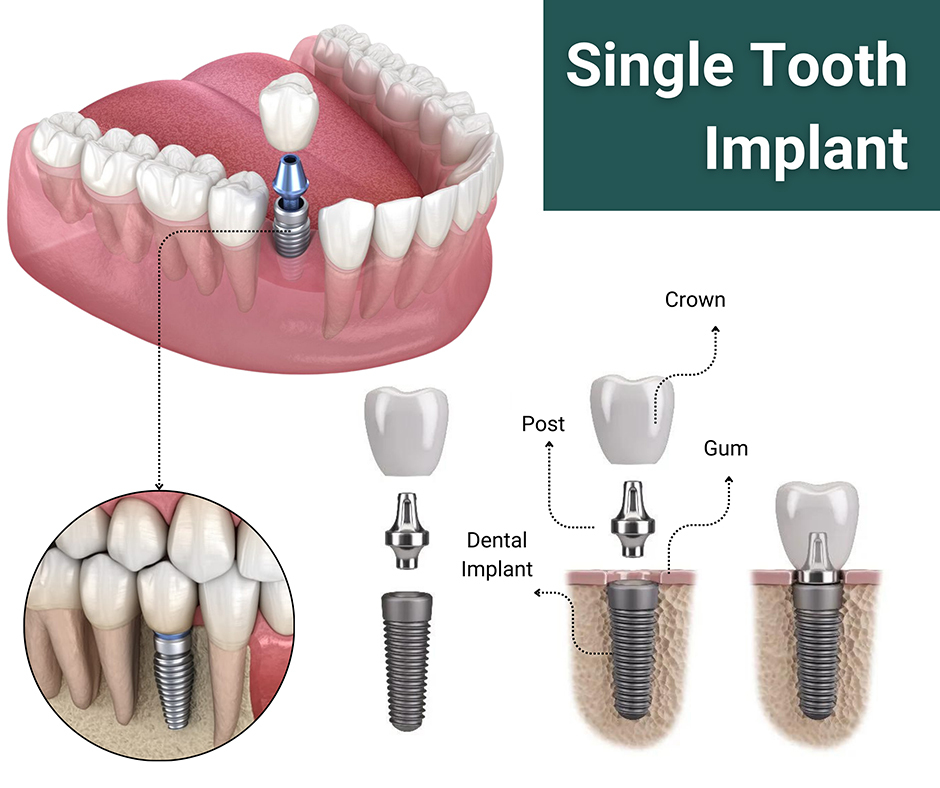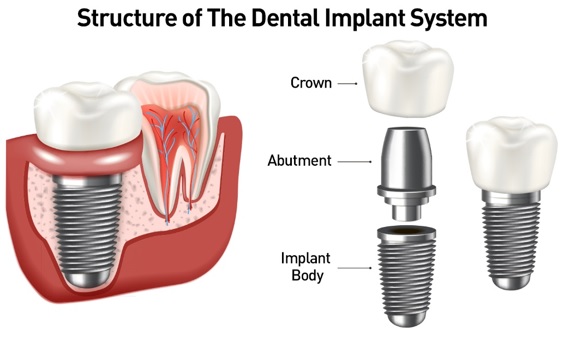The 5-Second Trick For Dental Implants
Table of ContentsDental Implants Things To Know Before You Get ThisThe smart Trick of Dental Implants That Nobody is Talking AboutGet This Report about Dental ImplantsOur Dental Implants PDFs
are medical tools surgically implanted right into the jaw to restore an individual's capability to chew or their appearance. They offer assistance for artificial (fake) teeth, such as crowns, bridges, or dentures. When a tooth is shed due to injury or condition, an individual can experience problems such as quick bone loss, malfunctioning speech, or modifications to eating patterns that cause pain.
Structure of The Dental Implant System picking oral implants, speak with your oral provider about the possible benefits and threats, and whether you are a candidate for the procedure. Things to take into consideration: Your general health is a crucial aspect in identifying whether you are an excellent prospect for dental implants, how long it will take to heal, and just how long the dental implant might stay in area.
Smoking may influence the healing procedure and decrease the long-lasting success of the dental implant. The healing process for the dental implant body may take a number of months or longer, throughout which time you normally have a temporary joint instead of the tooth. the dental implant treatment: Carefully comply with the dental hygiene directions offered to you by your dental provider.
The Ultimate Guide To Dental Implants
Implant failure can lead to the demand for another surgical treatment to deal with or change the implant system. Restores the capability to eat Recovers cosmetic appearance Helps keep the jawbone from diminishing as a result of bone loss Maintains the wellness of the surrounding bone and periodontals Assists keep adjacent (nearby) teeth stable Improves lifestyle Damages to bordering all-natural teeth during implant placement Injury to the surrounding cells during surgery, such as sinus perforation Injury throughout surgical procedure (for instance, crack of surrounding jawbone) Inadequate function, such as seeming like the teeth do not attack together typically A sensation that the tooth is loose or turning in area arising from a joint screw loosening Implant body failing (looseness of the implant body) because of systemic infection, which may be more probable in people with unchecked diabetes mellitus because of local infection in bone and gums sustaining the implant body due to postponed healing, which might be a lot more likely in patients that smoke Problem cleaning the gum tissues around the implant, resulting in inadequate dental hygiene Without treatment periodontal condition Post-surgical tingling because of nerve impingement or damage Constantly notify wellness treatment companies and imaging professionals that you have oral implants before any kind of magnetic vibration imaging (MRI) or x-ray procedures.
FDA is not knowledgeable about any type of damaging occasions reported for MRI or x-ray treatments with dental implants. Oral implants systems are commonly made from products that comply with global consensus criteria of the International Organization for Standardization (ISO) or ASTM International. These standards have information of what makes a safe material.
Oral dental implant systems are evaluated according to international agreement criteria. Biocompatibility screening, to reveal that physical call with the tool does not trigger problems like inflammation or sensitive response, is part of the examination that assists make certain the materials in the dental implant system are secure and do not create negative results when implanted in people.

Dental Implants Things To Know Before You Get This
Some people are not eligible for dental implant surgical procedure. It is for oral doctors to run on individuals with: acute illnessuncontrollable metabolic diseasebone or soft tissue illness or infectionIf these issues are dealt with, an individual can have the surgery. Dental Implants. In, oral doctors avoid operating people with: If individuals with any one of the above undertake oral implant surgical treatment, there is a higher risk of the implant stopping working
Some individuals have a jawbone problem that stops sufficient bone for an implant from developing. In such instances, a cosmetic surgeon may need to execute a ridge alteration. This entails raising the periodontal to subject the area of warped bone. The cosmetic surgeon will after that utilize a bone or bone alternative to fix and accumulate the area.
Oral dental look at this website implant surgical treatment is a customized procedure. It's not the exact same for everyone. The following provides a general introduction of what you can anticipate your dental expert, oral specialist, periodontist or prosthodontist to do: Put the implant operatively. Provide you time to recover. Connect the post and last crown, bridge or denture.
Next, your doctor will very carefully position this content the dental implant right into your jaw. Lastly, your doctor will reposition your gum tissues and close the laceration with stitches. If your implant is near the front of your mouth, your dental professional will certainly make a temporary tooth for you to put on up until you heal. In this way, you won't have a space in your smile while you recoup.
Dental Implants Fundamentals Explained
During the recovery phase, your jawbone ought to fuse to the dental implant. This process can take anywhere from 3 to 9 months.
Once your dental implant heals, your dentist can affix the abutment (small connector post) and your last repair (crown, bridge or denture). This normally takes regarding one hour to complete and might require a 2nd minor surgery. You should not feel any kind of pain during your oral implant procedure due to the fact that your provider will certainly use drug to numb your periodontals.